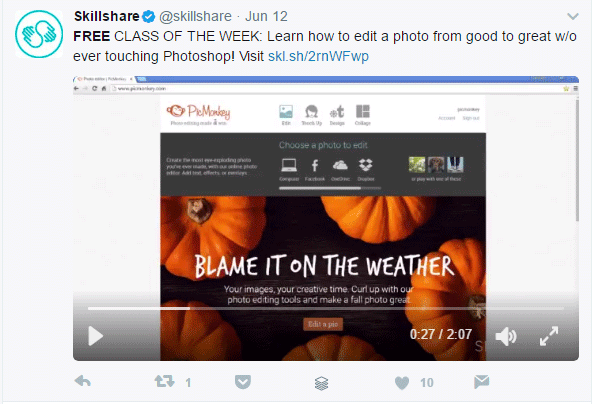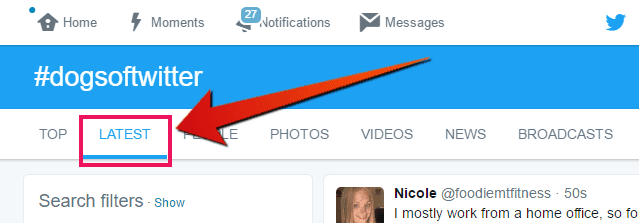To turn your business idea into money, and not just a digital ghost town with pixelated tumbleweeds blowing by, you need leads that will turn into customers. This takes some work and creativity.
I think a lot of people believe that as soon as they start their businesses, it will be all:
If that’s you, it’s time for a reality check.
In short, if you have an online business, and you want to be successful, you need an email list, and fast. Now that we’re on the same page there, let’s talk about how to build one. There are many theories as to the best ways to generate leads, but there’s one in particular that I believe is often undervalued—Twitter.
While Instagram and Snapchat are all the rage with the kids right now, the very nature of Twitter makes it a marketer’s dream. Think about it—more than any other social network, people go to Twitter with the intention of learning and consuming content.
Started as a micro-blogging site, Twitter has become one of the biggest news sources on the planet. It’s also the social media platform with the fewest barriers to connecting and communicating with others. Learning to harness the power of Twitter can take your business to another level, whether you’ve got a good foundation already, or you’re just getting started.
How? Well, you can use Twitter to build an email list by pairing it with what’s known as a lead magnet.
In this post, I’ll start with the basics of what a lead magnet is (feel free to jump ahead if you have a good grasp on this), and then how to promote one on Twitter, how to use Twitter as an amplifier for your content marketing, and finally, how to convert website visitors into leads.
Ready? Let’s get started!
What is a Lead Magnet?
Great question—I’m glad I pretended you asked! A lead magnet is simply something free that people get in exchange for their contact information (usually an email address).
When you enter your email into a form for some awesome free ebook, that’s a lead magnet. You’re opting in to someone’s email list to get something of value to you. Expect some marketing material to land in your inbox in the coming days. The best part (for everyone)? When done right, you’ll probably be glad to get that email. Here’s why…
One of the most important things about creating an effective lead magnet is to make sure your offer matches your audience. Create a lead magnet that your target market will find value in because they are your target market. That will ensure you get qualified leads likely to eventually buy from you.
Aligning your lead magnet with your audience also allows you to establish yourself as an expert in your space. Earn trust with your lead magnet and you’re that much closer to the sale when you do make an offer.
Types of Lead Magnets
So now that we’re clear on what a lead magnet is, let’s go over some types of lead magnets that are effective.
Content Lead Magnets
One of my favorite types of lead magnets is an offer of valuable content. Things like:
- A short ebook
- A whitepaper or industry report
- An actionable “how-to” guide
As mentioned, awesome content is an excellent way to establish expertise in your niche. Don’t create content that’s salesy or promotional for your business. At this point, you’re providing pure value without asking for anything in return (that part comes later).
Create content that’s valuable on its own, but also leaves people wanting more. That way, when you show up in their inbox again, they’ll be this glad to see you:
If you have a popular blog post, that’s a great start for a lead magnet. You can rewrite the content, beef it up a little, and turn it into a short ebook in no time.
In fact, you can use a tool like Beacon (they offer a free plan with branding) to create a perfectly formatted eBook from a blog post with very little effort.
Content Upgrades
Content upgrades are supplemental offerings to your existing free content. These go great with meaty “how-to” posts. You can offer a content upgrade to provide additional resources that will help people do what you’re teaching.
It’s an excellent way to earn trust and be helpful before you’ve made the sale. If you teach someone how to do something, and give them added tools to help them accomplish the task, now you’re cooking with gas!
People appreciate that you’re willing and able to help. And, of course, they’re much more likely to seriously consider your product or service after you prove yourself as a trusted resource.
Free Trial/Consultation/Sample Lead Magnets
These work a little bit differently in that your aim isn’t necessarily to collect an email address. Rather, you’re offering your product or service free for a limited time.
This gives prospects a chance to experience your offering and (hopefully) come back for more with money in hand.
That said, some of these strategies will require an email address to take advantage of the free trial/consultation/sample. This will build your email list with warm leads that have already expressed an interest in sampling your offering.
Use a solid email marketing strategy to organize these prospects so you can easily follow up later with an enticing offer.
For instance, if someone takes a free sample of a certain product, email them a unique offer on that product (or something very similar). You already know they’re interested. Now all that’s left is to make a compelling offer and ask for the sale.
Contest Lead Magnets
Creating a contest is another effective way to collect leads on Twitter. Get a prize, incentivize entering the contest, and spread the word.
Running a contest isn’t rocket science. But, again, make sure the prize is aligned with your target market. Here’s a great example…of what not to do:
Not gonna lie, that’s an awesome prize. I’d love to win it and I bet you would too. But how interested are you in the business running the contest?
Frankly, I can’t even tell you exactly what that company does. And I’m certainly not going to respond to any follow-up marketing after the contest is over. But I’ll still (just did) enter to win.
Now that we’ve examined several types of lead magnets, let’s go over how to spread the word using Twitter.
Like this Strategy? Get Free Instant Access To 28 Proven Marketing Strategies For Startups Here!
How to Promote a Lead Magnet Using Twitter
If you want to build your email list, you can (and should) promote your lead magnet directly on Twitter, especially the free trial/consultation/sample types.
Here’s an awesome example of a free sample lead magnet from Skillshare. They have a free weekly class and promote it directly on Twitter. Check out one of their tweets linking to one of their free classes:
You must create an account to get the class, and that, you guessed it, includes giving them your email. It’s a win-win. Interested people get a free class and Skillshare gets a new lead to market to. And if the company does its follow-up right, there’s another win in that the lead will get offers that fit their needs.
For content-based lead magnets (ebooks, whitepapers, guides, etc.), however, the best results come from content marketing that you draw people to using Twitter.
By that, I mean you want to use Twitter to drive people to free content (most likely your blog) first, without asking for anything in return (yet). So instead of advertising your promotion or lead magnet directly from Twitter, you will use Twitter to build a relationship and trust with your audience, first by offering them something highly valuable for free, like a killer blog post, with no strings attached.
Very few people will give up their email address for a free ebook or report from just anyone. People are protective of their email addresses these days, and they’re not going to cough them up to some rando startup just because they have a pdf file. If they don’t know you, they will always bring with them a dose of skepticism.
When you show people you’re a trusted resource before you offer a lead magnet, you’ll see a much higher opt-in rate. The way to do that is with free content marketing on your website, which then delivers a link to your lead magnet. When people like your tweets and your free content, some percentage of them will take the plunge to move things up a notch.
Concentrate on sending tweets to your blog posts to get people to your website. Once they’ve read some of your content and are on your site, they will see the value you provide. Then, hit them up with the lead magnet offer directly on your website. (I’ll go over the best ways to offer a lead magnet on your website in a moment.)
First, let’s go over some best practices for using Twitter to drive traffic to your blog posts.
How to Drive Traffic with Twitter
Driving traffic with Twitter is a process. It’s not complicated, but you’ll have to do each step outlined below to have sustained success.
Grow Your Twitter Following
First things first, to get people to click through to your website from Twitter, either to a lead magnet directly or to your content, you need targeted followers, and lots of them. Growing your Twitter following is an everyday practice.
You need new people seeing your content all the time. It’s like a non-stop networking event that you should go to every day. It does not, however, take an inordinate amount of time, and if you’re a Twitter user already, can be worked into your daily social media habits.
So how do you grow your following so you can build your email list? Well, unless you’re already known, people aren’t going to come to you. You have to go to them by using a follow-first strategy.
A follow-first strategy is simple and exactly what it sounds like. Find accounts you want to follow you, and follow them first. Many of them will follow you back. The ones that don’t aren’t interested and you can unfollow those after a while.
It’s easy to find your ideal customer with Twitter’s search function. Start by thinking about the hashtags your target audience would use and search them to find relevant accounts.
For instance, if you’re selling a product related to dogs, you want to find dog owners to follow. If you’re not familiar with popular hashtags for your audience, go to the search bar in Twitter and start with a # and start typing in a keyword.
In this case, we start with #dog and Twitter auto-populates the most popular hashtags that start with that.
Boom! #DogsOfTwitter is a perfect start. Search that hashtag and you’ll find a ton of accounts to follow. (Make sure you’re on the “Latest” tab so you see all people using the hashtags, not just the Tweets that Twitter deems “Top.”)
But don’t stop there. Also look at the other hashtags people are using along with #DogsOfTwitter. Start clicking on those and you’ll have no trouble finding your target audience on Twitter.
By following your ideal customers everyday, you’ll quickly grow a targeted following ready to click on your tweets and read your content.
Have a Compelling Pinned Tweet
When you pin a tweet, it stays at the top of your profile page until you remove it or replace it with a different one. Not having a pinned tweet is probably the most costly mistake in Twitter marketing. Fortunately, it’s also a quick fix.
To pin a tweet, just click on the down arrow in the top right of one of your tweets and click the “Pin to your profile page” option from the menu:
The reason it’s so important to have a great pinned tweet is that people will be visiting your profile page, especially when you do the follow-first technique to grow your following.
It goes like this: You follow someone and they get a notification. Then they come to your profile to check you out and see if they want to follow back. This is your opportunity to hook them with your pinned tweet—you know they’re going to see it.
Make your pinned tweet an offer for your lead magnet or a link to one of your most popular blog posts. On my personal profile, I’m currently linking to one of our blog posts, which is (ironically) about how to pin a tweet, with my pinned tweet.
It consistently gets shared and drives traffic back to our site without me lifting a finger.
But you’ll also need a tweeting strategy that works to drive traffic all day, every day. Fortunately, you can set this up so your Twitter account is always sending out your content on autopilot.
Here’s how to do it…
Set Up an Evergreen Content Queue
Twitter moves fast. Not every one of your followers is going to see every one of your tweets. In truth, it won’t even be close. That’s the nature of Twitter—it’s like a constantly flowing river, more like a firehose, actually.
Don’t believe me? Check out your Twitter Analytics and see the average impressions for any given tweet. Now compare that to your follower count. I guarantee only a small fraction of your followers will have the opportunity to see any given tweet.
With that in mind, you need to tweet out links to your “evergreen” content consistently. Evergreen content refers to posts that stay relevant over time.
Once you’ve identified your best, evergreen posts, I recommend using a tool to schedule your tweets with links, so you aren’t bogged down on Twitter all day.
Buffer has a free plan that allows you to set up a tweet schedule of days and times you want tweets to go out. Then you add tweets to the Buffer queue and it does the rest. They also provide great analytics for the tweets sent through Buffer. And they have a sweet “re-Buffer” feature where you can reschedule a tweet that did well with one click.
Or if you want to step it up a notch, you can use Post Planner to set up a recurring queue of tweets that go out in an endless loop. It is a paid tool, but it’s very reasonably priced. It works similar to Buffer in that you set the days and times you want your tweets to go out. But with Post Planner, you can “recycle” tweets in your queue. This feature sets it so once the queue is done, it goes back to the beginning and repeats the recycled tweets until you tell it to stop.
If you go this route, you do need to review your queue regularly to remove any tweets linking to content that is outdated or no longer relevant.
If you’re interested in this option, check out this comprehensive guide on how the recurring queue works on Post Planner.
Like this Strategy? Get Free Instant Access To 28 Proven Marketing Strategies For Startups Here!
How to Use Your Website to Promote Lead Magnets
Okay, now you’re getting people to your website content, give yourself a self-five.
But your job’s not done. Now it’s time to activate that traffic into leads.
There are several ways to convert website visitors into leads from the second they land on your site to when they’re ready to leave.
Welcome Mat Opt-Ins
A welcome mat is a full-page layover with a lead magnet offer. It’s shown immediately upon entering the site.
Here’s an awesome example from Sumo, which not-so-coincidently offers free software to install opt in forms, including welcome mats, on your website:
This displays on the entrance to a post about WordPress plugins.
Notice that while it’s a full-screen layover, it’s short and to the point. Remember that people just landed on your site to read content. They should be able to decide within a few seconds if this is something they want or not, so they can move on to what they came for.
You may think this is an unwelcome intrusion that no one will opt in to (I thought that too at one point). Nope.
In truth, our welcome mat at Social Quant converts at over 8 percent, a ridiculously high rate.
Embedded Form Opt-Ins
You should also put opt-in forms within the bodies of your blog posts.
Embedded forms are great for the content upgrades discussed earlier. That same Sumo post about WordPress plugins has an awesome content upgrade offer to download all the plugins right from the post, in exchange for your email, of course.
There is an awesome offer for anyone interested in this topic. They’ve made it super easy for you to get the 10 essential plugins they cover in the article. If you’re reading the post, it’s almost a no-brainer to opt in.
Even if you don’t have a content upgrade for a particular post, you can still install a semi-generic opt-in for a lead magnet.
Master marketer Neil Patel’s blog is peppered with opt-ins throughout his posts. I just reviewed this post and found 10 separate places on the page that lead to a landing page promoting his webinar. Here are just a couple:
Exit Intent Pop-Ups
Finally, don’t let your website visitors slip away without one more crack at getting their email address, with an exit intent pop-up.
The way these work is software recognizes when the cursor is moving to the top of the screen (where users can navigate away from the page), and that triggers the pop up. Sumo offers exit intent pop-ups, and they even have a free plan (with branding).
These are the least intrusive kind of pop ups—they were leaving anyway. And if you kicked butt providing value with the post, there’s a good chance people will opt in to your offer.
Spoiler alert: You’re probably going to see an exit intent pop-up when you leave this post. Move your cursor to the top of the page and see what happens. Assuming they haven’t changed it by the time you read this post, you just saw this exit intent pop up from Foundr.
It’s a great offer targeted to Foundr’s audience, people interested in starting a business. I bet it converts like crazy!
Like this Strategy? Get Free Instant Access To 28 Proven Marketing Strategies For Startups Here!
Wrapping Up
As you can see, building an email list from Twitter isn’t super complicated. It does, however, require a little time and effort to follow each of these steps.
The good news? Once you get the hang of the process, you’ll be a list-building machine and have leads coming at you from all sides.
What do you think? Is there anything I missed? Any questions you have about the process? I’d love to hear from you in the comments section below!



































